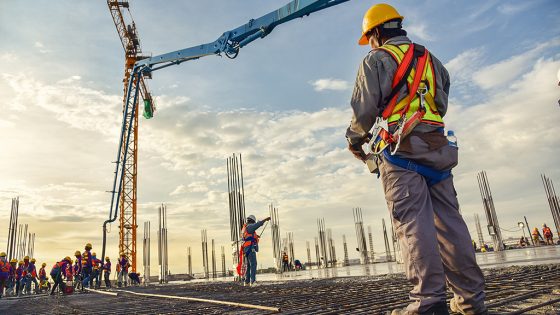Construction sector output decreased for the fourth consecutive month amid “heightened business uncertainty” in April, according to newly released data.
The latest S&P Global UK Construction Purchasing Managers’ Index (PMI) data, released on Wednesday (7 May), showed an activity index of 46.6.
This was up slightly from the March figure of 46.4 but still below the neutral 50 mark.
Civil engineering was the “weakest-performing” area of the construction sector last month with a reading of 43.1, according to S&P.
This was due to “a sharp rate of decline amid a lack of new work to replace completed projects”, it said.
While housing activity also remained in decline, it “showed a degree of resilience” with an activity index of 47.1 – its highest reading so far this year.
The pace of decline in commercial work was the worst since May 2020, though, with an index reading of 45.5 in April.
“Construction companies widely noted that heightened business uncertainty and worries about the broader UK economic outlook had weighed on client demand,” S&P said.
Lower workloads resulted in the fastest decline in purchasing activity for nearly five years in April, it noted, while average costs rose despite weaker demand conditions.
A “wide range of items” had risen in price, such as concrete, insulation and timber products. “Many firms reported that suppliers had also sought to pass on rising payroll costs,” S&P noted.
After the March PMI data showed that construction firms had shed jobs at the fastest rate since October 2020, employment levels in April sunk again, although the rate of decline “eased slightly”.
S&P added: “Subdued demand and rising pay pressures were cited as reasons for the non-replacement of voluntary leavers.”
The continued decline in activity contrasts with a more optimistic outlook.
S&P said that 41 per cent of construction firms in its survey panel forecast a rise in output over the next 12 months – and only 18 per cent predicted a decrease.
“This signalled a slight improvement in business optimism to its highest since December 2024,” S&P said.
“A number of firms commented on positive expectations for residential building work, despite ongoing domestic economic headwinds and fragile client confidence.”
Analysts reacted with pessimism to the latest PMI data.
Construction firms “are feeling the burden” from “stagnant demand” and increases since April to employer national insurance contributions and the national minimum wage, said Lauren Pamma, head of energy and infrastructure at Aldermore Bank.
“We’re beginning to see the fallout from the ongoing cross-border tariff war which will no doubt disrupt supply chains and impact prices further moving forwards,” she added.
“The outlook still remains unclear, and with developments emerging every day, SMEs will be monitoring the geopolitical landscape closely to see how the construction sector will be impacted.”
Atul Kariya, head of construction and real estate at MHA, said the latest data gave “little reason for celebration”.
But he suggested that an increase in activity could still come “as interest rates start to fall and the backlog of gateway two applications [to the Building Safety Regulator] eases. However, this rise is likely to be short-lived”.
Kariya added that the construction industry “in general will continue to bumble along the bottom” as it grapples with a high-tax environment and “uncertainty for investors caused by the tariffs”.

